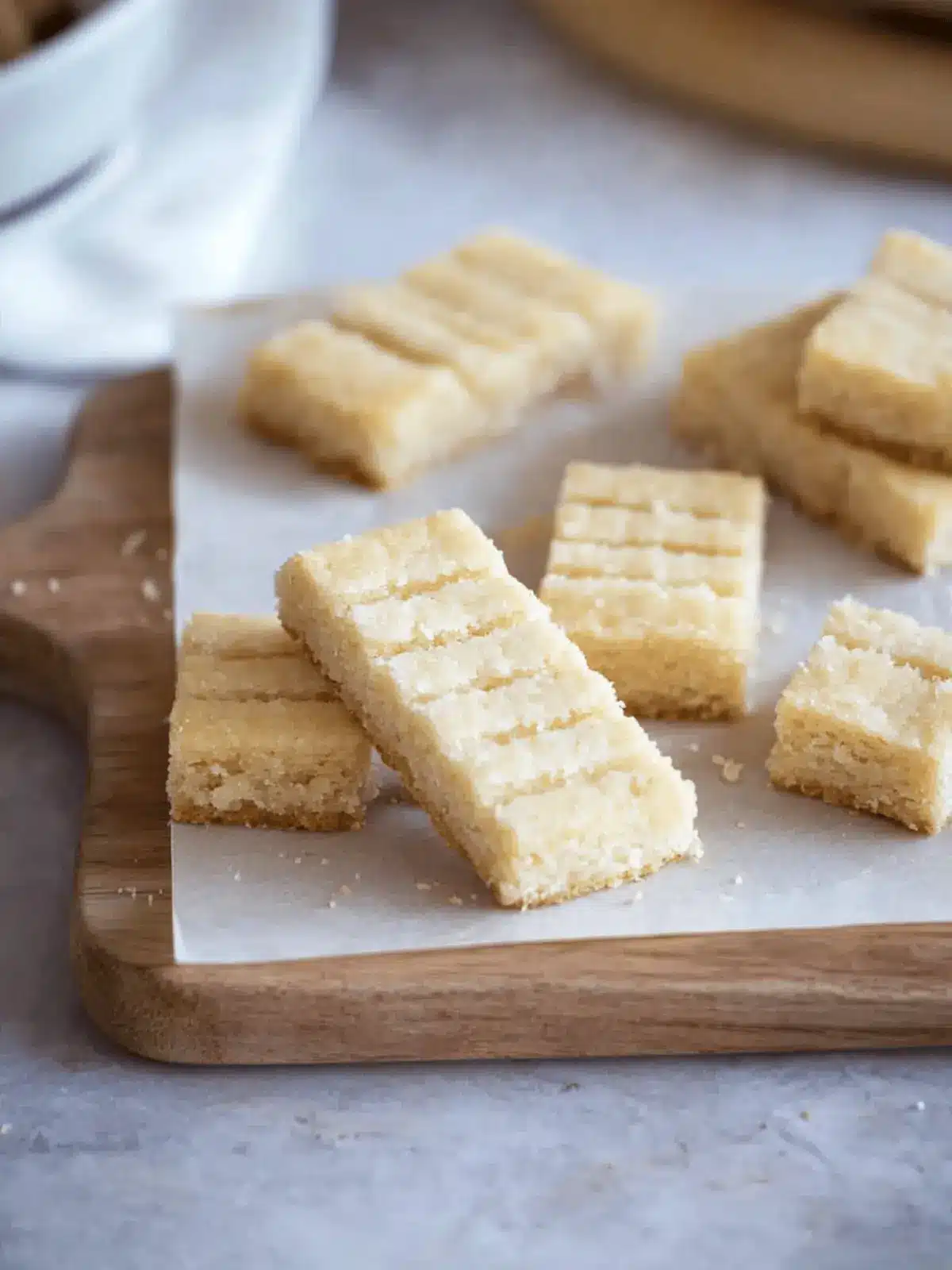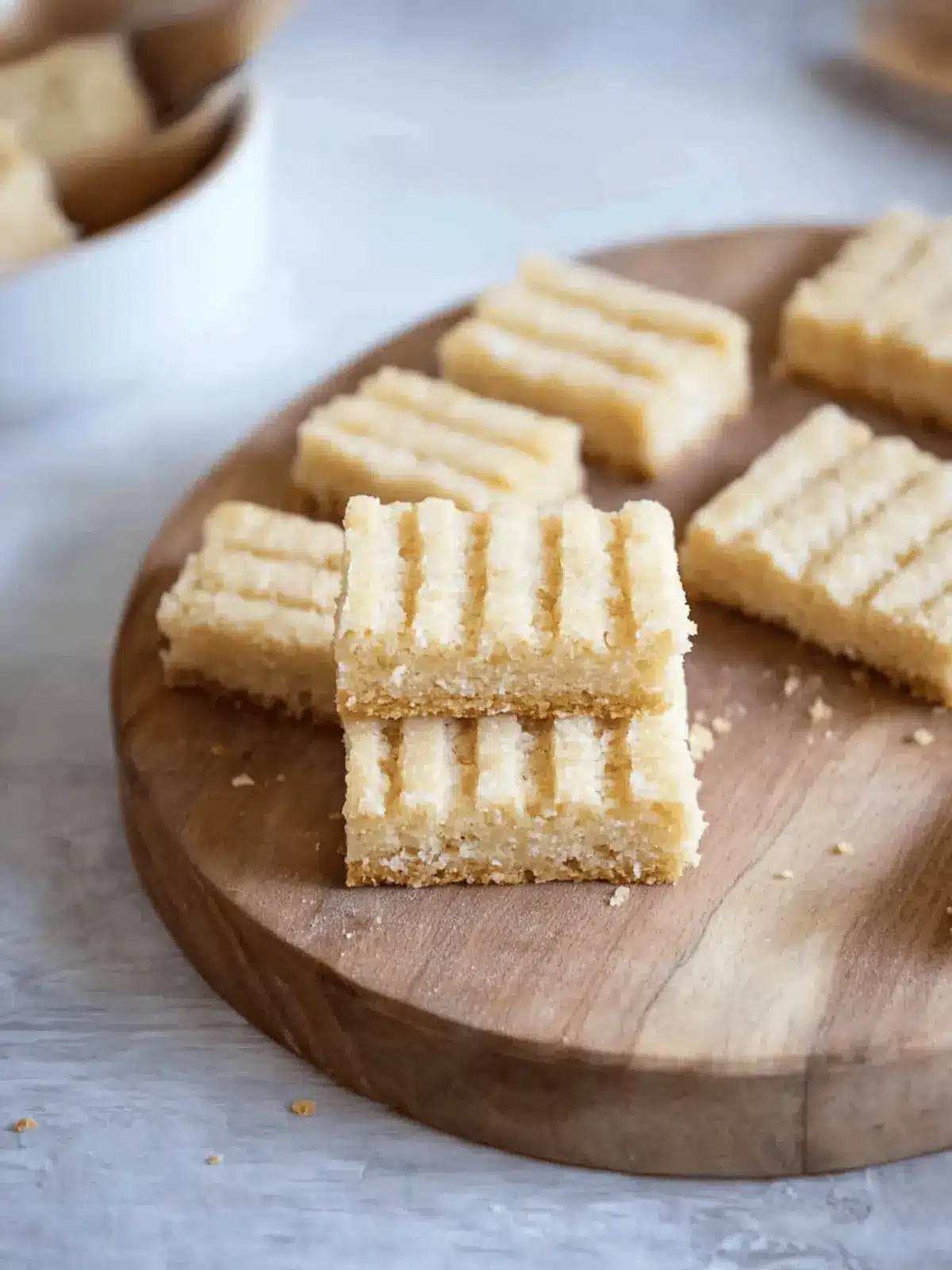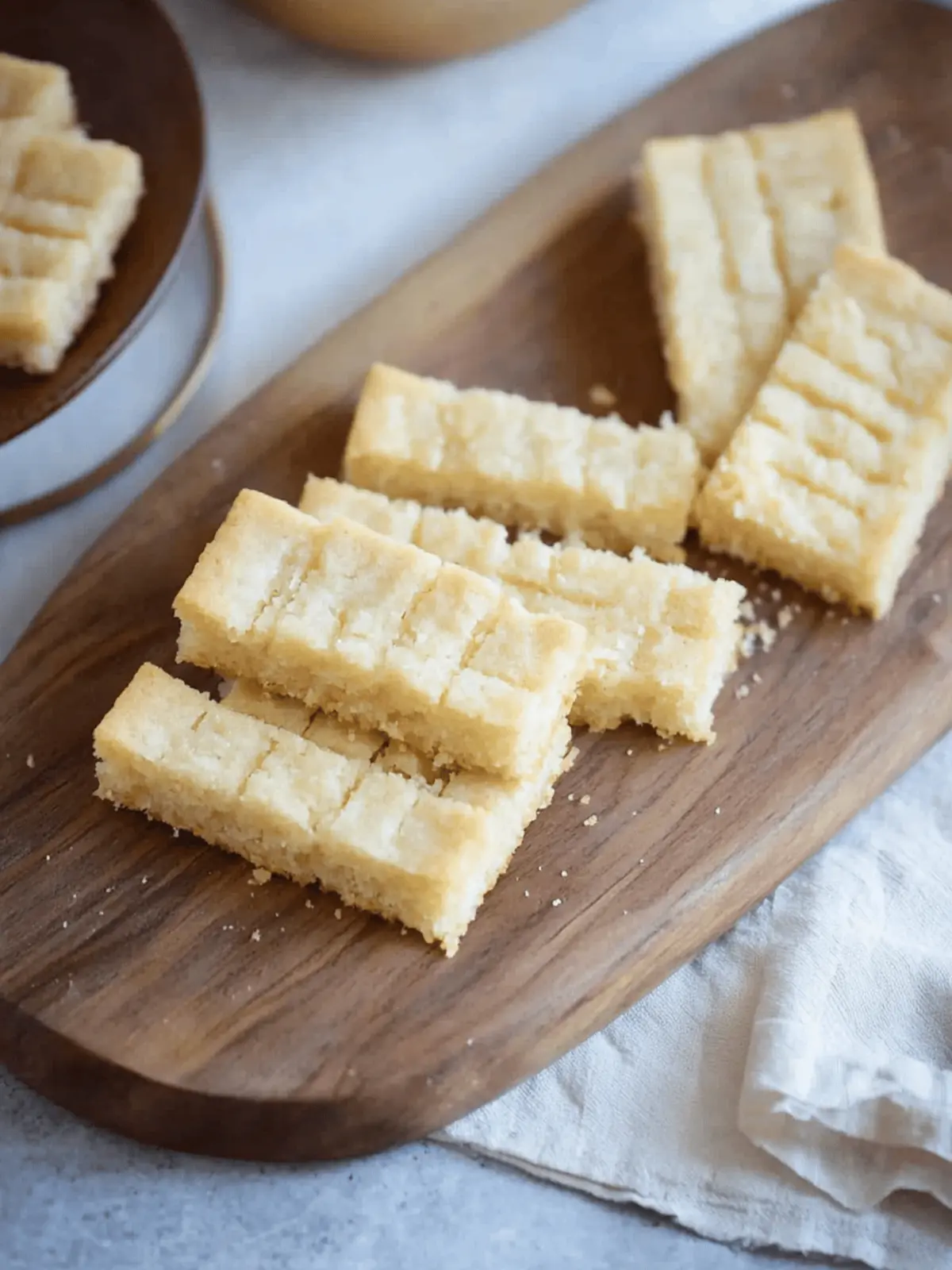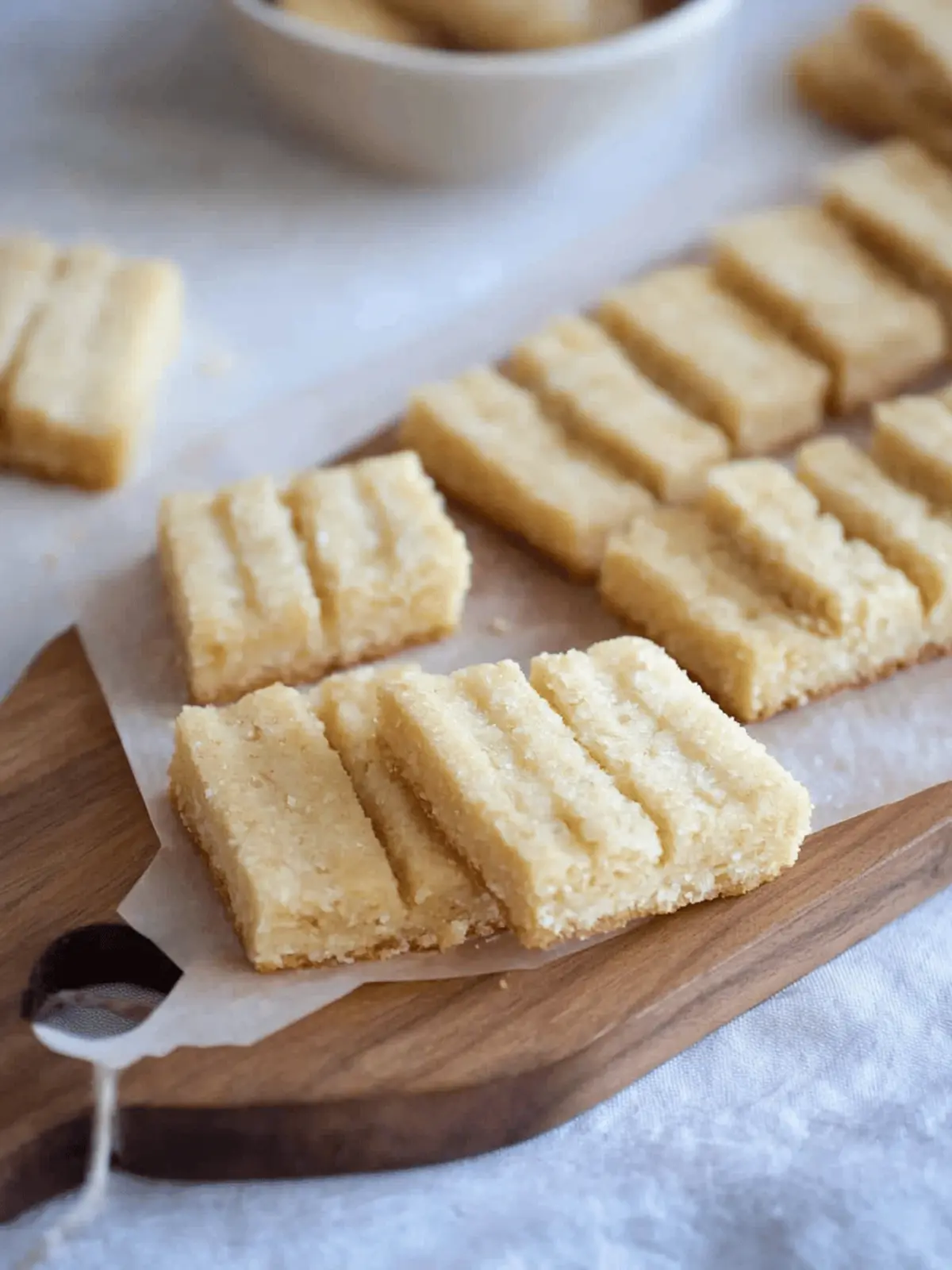When a chill fills the air and cozy moments beckon, nothing quite captures the spirit of comfort like a plate of traditional Scottish shortbread. The buttery scent wafting from your oven can turn even the most ordinary day into a delightful occasion. These enchanting cookies, made from simple ingredients, boast a melt-in-your-mouth texture that leaves you craving just one more bite.
I discovered this classic recipe while seeking a remedy for my fast food fatigue, and let me tell you, the outcome was a luscious treat that embodies the warmth of home. While perfect for afternoon tea or a family gathering, these shortbread cookies also invite creativity—think chocolate-dipped or even gluten-free options. Grab your high-quality butter, and let’s dive into this easy recipe that promises to bring warmth and nostalgia to your kitchen!
Why is Scottish Shortbread a Must-Try?
Irresistible Flavor: The rich, buttery taste of Scottish shortbread is unparalleled, evoking nostalgic memories with each bite.
Super Simple: With just a few basic ingredients, this recipe is beginner-friendly and perfect for home cooks.
Versatile Variations: Whether you prefer it plain, chocolate-dipped, or gluten-free, this recipe easily adapts to your preferences.
Perfect for Any Occasion: These cookies are a delightful addition to afternoon tea, holiday celebrations, or simply to enjoy with your favorite beverage.
Time-Saving Treat: With minimal prep and bake time, you can whip up a batch in no time, satisfying your cravings without hassle.
Scottish Shortbread Ingredients
-
For the Dough
-
Butter – Provides richness and moisture; opt for high-quality European butter for the best flavor.
-
Cane Sugar – Sweetens the cookies and creates a tender texture; can be substituted with white or baker’s sugar.
-
Vanilla Extract – Enhances flavor; almond or orange extract can be used for a twist.
-
Unbleached All-Purpose Flour – Gives structure to the cookies; measure carefully to avoid too much flour.
-
Cornstarch – Creates a lighter, more tender crumb; non-GMO is recommended for the best results.
-
Kosher Salt – Balances sweetness; omit if using salted butter.
-
For the Topping
-
Optional Sugar for Sprinkling – Adds texture and visual appeal; try Turbinado or Demerara sugars for a delightful finish.
How to Make Scottish Shortbread
-
Cream Butter and Sugar: In a stand mixer, beat softened butter until it’s light and creamy. Gradually add the cane sugar, mixing well for about 2-3 minutes before blending in the vanilla extract.
-
Mix Dry Ingredients: In a separate bowl, whisk together the unbleached all-purpose flour, cornstarch, and kosher salt. This will ensure a uniform distribution of ingredients.
-
Combine Mixtures: Gradually add the dry mixture to the butter mixture, stirring until a stiff dough forms. Embrace the blend of textures and aromas as they come together.
-
Knead Dough: Turn the dough onto a floured surface. Gently knead for a minute or two until it holds together nicely, ensuring it’s not too crumbly.
-
Shape and Chill: Press the dough into an ungreased baking pan. Prick it with a fork, score into bars, and chill in the fridge for at least 2 hours (or freeze for 1 hour) to firm it up.
-
Bake: Preheat your oven to 325°F (162°C). Bake for about 35 minutes, or until the shortbread is lightly golden around the edges. Keep an eye on it to prevent overbaking.
-
Cut and Store: While warm, cut the shortbread into bars. Let them cool completely on a wire rack before storing them in an airtight container.
Optional: Dust with a sprinkle of sugar before chilling for a decorative touch.
Exact quantities are listed in the recipe card below.
How to Store and Freeze Scottish Shortbread
Room Temperature: Store cooled Scottish shortbread in an airtight container at room temperature for up to 1 week to maintain freshness and crispness.
Fridge: If you live in a particularly warm climate, consider refrigerating the cookies in an airtight container for up to 2 weeks to prevent them from becoming too soft.
Freezer: For long-term storage, freeze the shortbread in a well-sealed container or freezer bag for up to 6 months. Let them thaw at room temperature when you’re ready to enjoy them again.
Reheating: If desired, you can warm slightly in the oven at 300°F (150°C) for 5-7 minutes to restore their delightful texture before serving.
Make Ahead Options
These traditional Scottish shortbread cookies are ideal for busy cooks looking to save time without sacrificing taste. You can prepare the dough up to 24 hours in advance; simply wrap it tightly in plastic wrap and refrigerate. To maintain the perfect texture, be sure to chill the dough for the full time before serving. If you prefer, you can also cut the shaped dough into bars and freeze them for up to 3 months. When you’re ready to bake, just pop them in a preheated oven directly from the freezer, adding a couple of extra minutes to the baking time. This way, you’ll always have fresh, buttery treats on hand, perfect for any occasion!
Expert Tips for Scottish Shortbread
-
Quality Ingredients: Use high-quality butter for the best flavor in your Scottish shortbread. The butter should be at room temperature for easy creaming.
-
Accurate Measuring: When measuring flour, spoon it into your measuring cup and level off with a knife. Overpacking can result in dry cookies.
-
Chill for Success: Don’t skip the chilling step! It firms up the dough, ensuring the perfect crumbly texture when baked.
-
Monitor Baking: Keep an eye on the shortbread as it bakes; they should be lightly golden at the edges but not brown, which can lead to a dry texture.
-
Address Crumbliness: If your dough feels too crumbly to hold together, add a teaspoon of cold water and gently knead to bring it back together.
-
Experiment with Variations: Feel free to customize your Scottish shortbread! Try adding chocolate chips or substituting part of the flour with a gluten-free blend for a twist.
What to Serve with Scottish Shortbread?
When it comes to enjoying your freshly baked shortbread, pairing it with delightful accompaniments can elevate the experience to new heights.
-
Freshly Brewed Tea: The classic choice for shortbread; the warmth and depth of flavors complement the buttery cookie beautifully.
-
Rich Hot Chocolate: Indulge in a cozy mug of hot chocolate; its creamy sweetness pairs perfectly with the crumbly texture of the shortbread.
-
Seasonal Fruit Preserves: Try a dollop of homemade raspberry or apricot preserves; the tartness contrasts exquisitely with the sweet richness of the cookies.
-
Whipped Cream: Light and airy, a scoop of whipped cream can add a delightful creamy texture that blends beautifully with the melt-in-your-mouth shortbread.
-
Cheese Plate: For an unexpected twist, serve your cookies with a selection of mild cheeses. The combination of flavors offers a sophisticated palate experience.
-
Almond Milk or Oat Milk: For a dairy-free option, serve your shortbread with a glass of almond or oat milk; their subtle flavors harmonize wonderfully with the cookies.
Imagine a delightful afternoon gathering with friends, your plate of Scottish shortbread taking center stage, beautifully complemented by these delicious pairings that invite conversation and connection.
Scottish Shortbread Variations
Customize your Scottish shortbread to fit any palate with these delightful tweaks and twists!
-
Gluten-Free: Swap all-purpose flour for a gluten-free flour blend or mix almond flour for a delicious gluten-free option.
-
Chocolate-Dipped: Dip cooled shortbread into melted chocolate—dark, milk, or white—for a luxurious treat that adds a sweet twist.
-
Herb-Infused: Mix in finely chopped fresh herbs like rosemary or lavender for an aromatic touch that elevates the traditional flavor.
-
Citrus Zest: Add zest from a lemon or orange to the dough for a bright, refreshing flavor that beautifully balances the butteriness.
-
Nuts or Seeds: Incorporate chopped nuts such as almonds or walnuts, or sprinkle sesame seeds for added crunch and nuttiness.
-
Spiced Delight: Fold in a touch of ground cinnamon or ginger for a warm, cozy flavor that’s perfect for fall or winter gatherings.
-
Extra Sweet Crunch: Top off the dough with a sprinkle of coarse sugar before baking for an added crunch and visual appeal.
-
Caramel Drizzle: Once cooled, drizzle with homemade or store-bought caramel sauce for an indulgently decadent finish that delights the senses.
Scottish Shortbread Recipe FAQs
What type of butter is best for Scottish shortbread?
Absolutely! For the best flavor, I highly recommend using high-quality European butter, like Kerrygold. This butter adds richness and gives you that melt-in-your-mouth experience. If you prefer, you can opt for salted or unsalted butter—just remember to adjust the salt in your recipe accordingly.
How should I store the Scottish shortbread once it’s baked?
Very! Once cooled, store your Scottish shortbread in an airtight container at room temperature for up to 1 week. This keeps them nice and crisp. If you live in a humid climate, consider refrigerating them to maintain their texture for up to 2 weeks.
Can I freeze the Scottish shortbread for later use?
Absolutely! To freeze your shortbread, let the cookies cool completely, then place them in a well-sealed freezer bag or container. They can be frozen for up to 6 months. To enjoy, just let them thaw at room temperature, or warm them slightly in the oven at 300°F (150°C) for about 5-7 minutes before serving.
What should I do if my shortbread dough is too crumbly?
No worries! If your dough feels crumbly and isn’t coming together, simply add a teaspoon of cold water and gently knead the dough to combine. This should help it hold together nicely. Also, make sure you’re measuring your flour accurately—too much can lead to a drier dough.
Can I make a gluten-free version of this Scottish shortbread?
Absolutely! For a gluten-free option, substitute the all-purpose flour with a 1-to-1 gluten-free flour blend. Alternatively, you can mix almond flour with gluten-free flour for a delightful twist. Just be aware that the texture might vary slightly, but it will still be delicious!
Is it safe for pets to eat Scottish shortbread?
Not at all! While the ingredients are generally safe for humans, Scottish shortbread contains butter and sugar, which aren’t healthy for pets. It’s best to keep these delightful cookies as a special treat just for yourself.

Scottish Shortbread Made Easy: Buttery Bliss Awaits
Ingredients
Equipment
Method
- Cream Butter and Sugar: In a stand mixer, beat softened butter until it's light and creamy. Gradually add the cane sugar, mixing well for about 2-3 minutes before blending in the vanilla extract.
- Mix Dry Ingredients: In a separate bowl, whisk together the unbleached all-purpose flour, cornstarch, and kosher salt.
- Combine Mixtures: Gradually add the dry mixture to the butter mixture, stirring until a stiff dough forms.
- Knead Dough: Turn the dough onto a floured surface. Gently knead for a minute or two until it holds together nicely.
- Shape and Chill: Press the dough into an ungreased baking pan. Prick it with a fork, score into bars, and chill in the fridge for at least 2 hours (or freeze for 1 hour).
- Bake: Preheat your oven to 325°F (162°C). Bake for about 35 minutes, or until the shortbread is lightly golden around the edges.
- Cut and Store: While warm, cut the shortbread into bars. Let them cool completely on a wire rack before storing.



